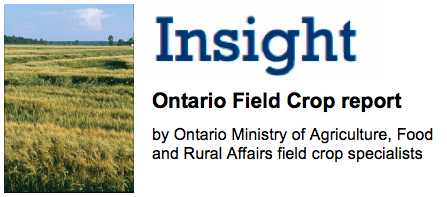Canola/Edible Beans: Brian Hall
Canola harvest progress is slow with high seed moisture, uneven maturity and higher than normal green seed counts. Delaying harvest to avoid drying costs is risky as high shattering losses from wind, or heavy rain may occur. If necessary, use a desiccant to speed dry down. Glyphosate is best used for perennial weed control, but preforms poorly as a desiccant. Immature canola that received a light frost should be left to continue pod fill allowing green seeds to mature. Monitor fields daily to assess. Expect to see some speckling of pods. At temperatures of -2°C or below, severe damage may occur, photosynthesis stops, plant wilting occurs, pods appear translucent and wilt several hours later. This is a sign of pod desiccating rapidly leading to pod drop or shattering. If this occurs, swath as soon as possible when the crop is damp from dew to reduce further pod shattering. A heavy frost destroys the enzyme in seed that allows it to clear the green colour, and delaying harvest or storing the canola will not help cure the green seed.
Edible Bean harvest is 2 weeks behind normal. Yields have varied widely from 15 -30 cwt/ac. Quality has been good. When using glyphosate for crop dry-down, the response typically begins to take longer due to cooler temperatures and cloudy weather which slows plant metabolism. Check with your dealer about concerns around crop maturity and permitted pre-harvest treatments.
Cereals: Peter Johnson
Winter cereal planting is in high gear as edible beans, early soybeans and corn silage are harvested. Planting intentions vary widely, from up slightly in high yield areas to significantly less in areas hard hit with fusarium. Early planted wheat always has the best yield potential: don’t hold back on wheat acres at this time of year. Rotation research clearly shows huge benefits to wheat in the rotation: 19 bu/ac more corn (Ridgetown), and 5 bu/ac more soybeans (Ridgetown, Elora). Growers planting winter wheat after corn (silage, sweet or grain) must plant a moderately resistant variety (MR, www.gocereals.ca) to be eligible for Production Insurance.
All wheat seed needs to be treated with a fungicide that includes Dividend (difenaconazole). This is the only fungicide that controls soil borne dwarf bunt. Seeding rates are always a challenge with drill technology. Target 1.5 million seeds/ac (22 seeds/ft of row) on clay loam or lighter soils, 1.8 million (26/ft) on heavy clay soils, during the optimum seeding window. If seeding 10 days before the optimum window, reduce seeding rates 25%. If seeding dates get late (after Oct 15th), increase rates by 25%.
Corn/Corn Silage: Greg Stewart/Joel Bagg
Some frost damage occurred during the morning of Sept. 17th , mostly above the 2900 Crop Heat Unit (CHU) line. Frost injury was patchy in low lying areas. Early assessment indicates there was leaf damage but stocks appear unharmed and able to contribute to grain fill. Refer to “ Corn and Cold September Nights” http://bit.ly/coldseptnights.
Corn silage harvest has started. Harvesting corn silage at the correct moisture is critical for obtaining optimal silage fermentation and animal performance but this year field variability is making this a challenge. Walk your fields and monitor whole plant moistures. Silage moistures that are too low result in poor packing and fermentation which increases dry matter losses, heating and spoilage, poor bunk life, and lower starch digestibility. Kernel processors can help compensate to some extent. Harvesting at moisture levels above 70% will result in lower yield, high levels of butyric acid, high dry matter losses, silo seepage, poor feed quality, reduced palatability and lower intake.
The best silage fermentation and livestock performance occurs when whole plant moisture is 65 to 70%. Watch for variability between and within fields. Recommended moisture ranges are 65 - 70% for horizontal, 62 - 68% for bag, and 62 - 67% for most upright silos.
Whole plant silage moisture is difficult to accurately determine. The traditional one-half to two-thirds milk line guideline is limited by considerable variation due to dry weather and hybrid differences. Chop a sample and measure the moisture content with a microwave, commercially available tester (eg. Koster) or by laboratory analysis. This procedure takes a little time, but is worthwhile when you consider the impact correct moisture will have on forage quality and animal performance for the whole year. Microwaves and on-farm testers typically under-estimate field moistures by up to 3%. In a typical year corn silage dries at about 0.5 % moisture per day. Refer to “Harvesting Corn Silage At the Right Moisture” http://fieldcropnews.com/?p=7953 and “Pricing Corn Silage In 2013” http://fieldcropnews.com/?p=7977.
Soybeans: Horst Bohner
Harvest has begun on short season varieties while many fields are expected to be ready for harvest in October. Most fields are past the point where frost will have a major impact but soybeans that have not reached full maturity can be impacted by an early frost. Studies indicate that soybeans are easily injured by frost until they reach physiological maturity which is attained at the R7 stage, which is when one pod has changed to brown on the main stem) Frost after physiological maturity generally does not damage soybean plants if pods remain intact. Prior to this stage, soybeans will be injured both for grain and seed purposes. Freezing during the green pod stage (R6) will result in damaged beans with a greenish "candied" appearance. Even moderately frosted beans with a greenish colour and slightly wrinkled seedcoat are considered as damaged soybeans and can be discounted if present in excess of limits (3%) for No. 2 Canada soybeans. The seed will eventually dry down with a wrinkled seedcoat and germination will be severely affected.



